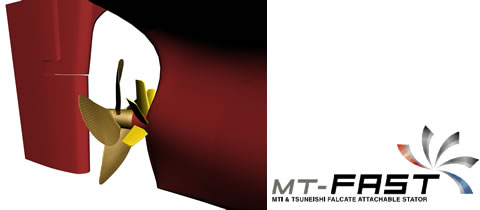Press Releases
Announcing development of “MT-FAST,” a new fuel and energy saving fitting that will be mounted on a chip carrier built at Tsuneishi factory. Operation starts in June.
February 13, 2008
TSUNEISHI Holdings Corporation (Head office: Fukuyama-city Hiroshima, CEO: Katsushige Kambara) and the Yusen Kaisha Line group’s company, MTI (Monohakobi Technology Institute, Head office: Chiyoda-ku, Tokyo, CEO: Yutaka Yasunaga) have co-developed a new hull fitting, the “MT-FAST (patent pending),” which is expected to increase fuel efficiency.
“MT-FAST” takes its name from the development company “MTI & Tsuneishi” and the first letters of “Falcate,” “Attachable,” and “STator,” all describing characteristics of the new fitting. “MT-FAST” can collect the loss energy that comes from rotational flow generated by propeller rotations. Experiments showed fuel savings at a rate of about minus 4%. For the wooden chip carrier now being built, this will result in an estimated 300 tons of fuel and 1,000 tons of CO2 saved each year. Additionally, “MT-FAST” can be mounted to existing ships as well as newly built ships.
This highly versatile hull fitting is one technology that is receiving a lot of attention, as the need to reduce fuel consumption grows more urgent, due both to constantly increasing fuel costs and greater consideration being given to environmental concerns.
The new hull fitting “MT-FAST” will be mounted mainly to bulk carriers of the Nippon Yusen Kaisha Line and its group companies. To enhance the fitting’s practicality, fuel efficiency will be documented during the course of actual ship operations on comparable ships both fitted with and lacking the “MT-FAST.”
TSUNEISHI Holdings Corporation will apply “MT-FAST” to AFRAMAX tankers, HANDIMAX, PANAMAX, and CAPE size bulk carriers sequentially. By 2010, most new ships built will include “MT-FAST” as standard equipment.
Note: Hull fitting
This is equipment attached to the hull below the waterline to collect the loss energy. In essence, energy-savings are realized principally by considering the shape of the ship. However, in commercial carriers the need for a high load capacity makes it difficult to realize efficiency based solely on hull shape. To help resolve this problem, hull fittings are attached to the ship to increase efficiency of movement.


